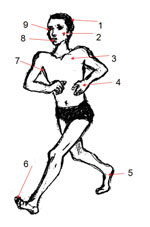Self-Assessment Questions (SAQs) for Study Session 3
Now that you have completed this study session, you can assess how well you have achieved its Learning Outcomes by answering these questions. Write your answers in your Study Diary and discuss them with your Tutor at the next Study Support Meeting. You can check your answers with the Notes on the Self-Assessment Questions at the end of this Module.
SAQ 3.1 (tests Learning Outcomes 3.1 and 3.3)
Identify the components of personal hygiene that are numbered in Figure 3.9.
Answer
1 Hair hygiene; 2 Face hygiene; 3 Body hygiene; 4 Hand hygiene; 5 Feet hygiene; 6 Nail hygiene; 7 Armpit hygiene; 8 Oral hygiene; 9 Eye hygiene.
SAQ 3.2 (tests Learning Outcome 3.3)
Write the names of one or two communicable diseases or conditions and the recommended frequency of washing or cleaning for the following respective components of personal hygiene.
| Components | Diseases/conditions | Recommended frequency of cleaning |
|---|---|---|
| Eye hygiene | ||
| Hair hygiene | ||
| Body hygiene | ||
| Oral hygiene | ||
| Feet hygiene | ||
| Hand hygiene | ||
| Clothes hygiene |
Answer
| Components | Diseases/conditions | Recommended frequency of cleaning |
|---|---|---|
| Eye hygiene | Trachoma, conjunctivitis | Daily every morning and when the face is dirty |
| Hair hygiene | Dandruff, Tinea capitis, infestation (lice, nits) | Twice weekly; preferably once every other day |
| Body hygiene | Bad smell, scabies | Once or twice a week |
| Oral hygiene | Tooth decay, gum infection, bad breath | Brushing twice a day; rinsing after each meal |
| Feet hygiene | Athlete’s foot, wound | Every day |
| Hand hygiene | Diarrhoea, typhus fever, dysentery, ascariasis | Every time after touching contaminated surfaces; every time before eating and touching clean surfaces |
| Clothes hygiene | Bad smell, unclean, relapsing fever, typhus | Once or twice a week |
SAQ 3.3 (tests Learning Outcomes 3.2 and 3.5)
Given your answer for SAQ 3.2, which components are most important for your locality?
Answer
Your choice of components of personal hygiene depends on the burden of communicable diseases in your area. If diarrhoea and trachoma are prevalent in your locality, then hand and eye hygiene will be important to you. Many other answers are possible.
SAQ 3.4 (tests Learning Outcomes 3.4 and 3.6)
One day at a wedding, you observe some guests lining up for handwashing, while other people have started to eat the feast without handwashing. Among those who washed hands, some used soap, while others just used running water without soap. Are these acceptable or poor handwashing practices?
Answer
Handwashing with soap is a good or acceptable personal hygiene practice, while not washing with soap and only washing with running water is poor handwashing practice. Not washing the hands at all is obviously not good!
SAQ 3.5 (tests Learning Outcome 3.6)
The purpose of handwashing is to get rid of microorganisms from our hands. Suppose you want to educate family members on proper handwashing and demonstrate the correct procedure to follow. What will you tell them to do? What are the critical situations for proper handwashing they should be aware of?
Answer
The stepwise procedure is:
- Remove visible dirt with running water. Always wash hands under running water, preferably with hot water.
- Apply soap after wetting the hands. Bar, powdered and liquid soaps can be used. Lather well.
- Rub hands vigorously together for 15–30 seconds, paying particular attention to fingertips, thumbs, under the fingernails and between the fingers. Effective handwashing also includes the backs of the hand, palms and exposed portion of the arm.
- Rinse the hands with clean running water.
- Dry with a clean cloth or disposable towel, or let them dry in the air.
Critical situations include:
- After using the toilet (or disposing of human or animal faeces).
- After cleaning a child’s bottom.
- Before preparing or handling cooked/ready-to-eat food.
- Before eating food or feeding children.
- Before and after coming in contact with an infected wound.
SAQ 3.6 (tests Learning Outcome 3.7)
SAQ 3.5 addressed educating household members. What activities would you consider for the planning of personal hygiene promotion at community level?
Answer
Here are some of the elements and activities you should include in your plan for community hygiene promotion:
- Identify which components of personal hygiene need to be promoted.
- Identify the target audience.
- Prepare teaching and educational materials.
- Identify who to involve in hygiene education.
- Engage actively in hygiene education.
- Identify indicators for monitoring and evaluating hygiene promotion performance.
SAQ 3.7 (tests Learning Outcome 3.8)
Go back to SAQ 3.5 and your answer. Imagine that you have given this handwashing promotion to a group of households. How will you evaluate whether the promotion was effective?
Answer
To monitor and evaluate the effectiveness of your promotion, you would need to identify indicators to show you if the performance of personal hygiene was correctly done or not. You would need to observe people’s behaviour towards handwashing or ask them about their practice. If you can see that the household members are handwashing before and after critical times, i.e. good hygienic practice, then you could say your promotion had been successful. If not, and you observed poor hygienic practice by some people, then you should consider how you might improve the situation. This might be more promotional work with the group of households, perhaps taking a slightly different approach if the initial training had had limited success.
Summary of Study Session 3

